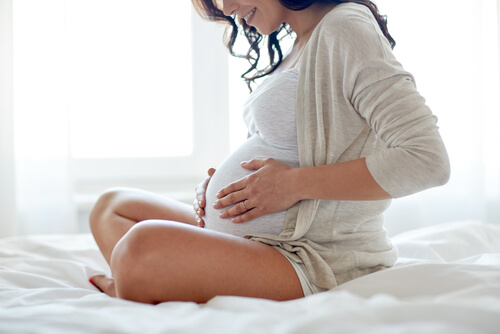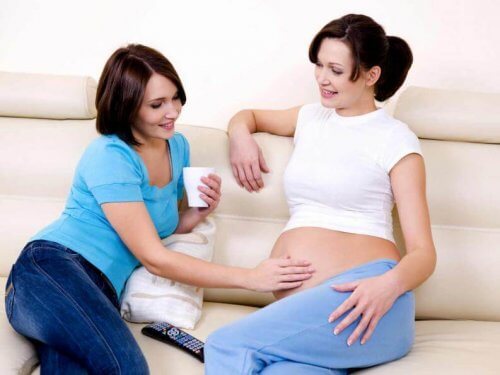Stimulating Your Baby's Movement during Pregnancy

You should discuss any questions or doubts you may have during your pregnancy with your doctor.
It’s also a good idea to talk with your obstetrician about techniques that allow you to stimulate your baby’s movement.
Space and your baby’s movement
Don’t forget that your baby experiences the same activities and needs as other people, though still in the womb. That means that sometimes your baby needs to sleep.
While your baby is sleeping, you aren’t likely to feel a lot of movement, if any.
Some mothers have less amniotic fluid in their uterus. Therefore, the space their babies have to move around is reduced.
Another detail to keep in mind is that, during the last 4 weeks of gestation, your little one is preparing for birth. His periods of rest will become longer, aiding in his growth and development.
Is it really necessary to stimulate your baby’s movement?
Yes, mothers need to stimulate their baby’s movement during the early stages of gestation.
Many specialists believe it’s during this time that human beings begin to strengthen their brains. Stimulation will allow them to begin to develop their senses before the time of birth.
The constant relationship between mother and baby, even in the mother’s womb, will allow for a strong bond between them.
It will also help your baby feel safe and secure, which allows her to be a healthy individual.
This will help her relate well to other people, developing trusting relationships. This will be especially true regarding the baby’s relationship with her mother and other close family members.

How can I stimulate my baby’s movement?
With lights
The most comforting place that a baby can be is in his mother’s uterus. It’s warm and dark, and your baby finds himself literally floating around inside it.
Inside your womb, your baby has everything he needs to live.
By shining a light on your abdomen and moving it from one spot to another, you can catch your little one’s attention.
By doing so, you’ll also stimulate movement.
“Mothers need to stimulate their babies’ movement during the early stages of gestation”
With sound
Another way to stimulate your developing baby’s movement is with music, placed at medium volume.
You can choose a favorite song of your own or your partner’s, classical music, relaxing music… it’s up to you.
The music will produce sound waves that will pass through the amniotic liquid around your baby. The movement of these waves are easily perceived by your baby.
If you want to dance to the music a little as well, then the stimulation is even greater.
Through massage
During the third trimester of your pregnancy, you can more easily feel your baby’s feet, back or hands. When you do, seize the moment and give your baby a massage.
Not only will you be stimulating your baby’s movement, but you’ll also be strengthening the bond between both of you.
Communication with your baby and healthy eating
Speaking with your baby
The most beautiful sound a baby can hear from the uterus is her mother’s voice.
Speaking with your baby will not only help her learn to recognize your voice, it also stimulates her healthy growth and development.

You can have a direct conversation with your baby. If you already know your baby’s sex and/or name, you can address your baby more specifically.
Another good idea is to read out loud to your baby or sing to her. These are just a few ways in which you can interact with your unborn baby.
Healthy eating
Every food the mother consumes during pregnancy can be tasted by her baby during the third trimester.
You should include a variety of foods in your diet, including fish, fruits, vegetables and meat.
Of course, you need to avoid alcohol and tobacco while you’re pregnant. These substance can cause irreparable damage to your baby’s health.
Every mother will experience what works best to stimulate her baby, and thus put the best techniques into practice.
You should discuss any questions or doubts you may have during your pregnancy with your doctor.
It’s also a good idea to talk with your obstetrician about techniques that allow you to stimulate your baby’s movement.
Space and your baby’s movement
Don’t forget that your baby experiences the same activities and needs as other people, though still in the womb. That means that sometimes your baby needs to sleep.
While your baby is sleeping, you aren’t likely to feel a lot of movement, if any.
Some mothers have less amniotic fluid in their uterus. Therefore, the space their babies have to move around is reduced.
Another detail to keep in mind is that, during the last 4 weeks of gestation, your little one is preparing for birth. His periods of rest will become longer, aiding in his growth and development.
Is it really necessary to stimulate your baby’s movement?
Yes, mothers need to stimulate their baby’s movement during the early stages of gestation.
Many specialists believe it’s during this time that human beings begin to strengthen their brains. Stimulation will allow them to begin to develop their senses before the time of birth.
The constant relationship between mother and baby, even in the mother’s womb, will allow for a strong bond between them.
It will also help your baby feel safe and secure, which allows her to be a healthy individual.
This will help her relate well to other people, developing trusting relationships. This will be especially true regarding the baby’s relationship with her mother and other close family members.

How can I stimulate my baby’s movement?
With lights
The most comforting place that a baby can be is in his mother’s uterus. It’s warm and dark, and your baby finds himself literally floating around inside it.
Inside your womb, your baby has everything he needs to live.
By shining a light on your abdomen and moving it from one spot to another, you can catch your little one’s attention.
By doing so, you’ll also stimulate movement.
“Mothers need to stimulate their babies’ movement during the early stages of gestation”
With sound
Another way to stimulate your developing baby’s movement is with music, placed at medium volume.
You can choose a favorite song of your own or your partner’s, classical music, relaxing music… it’s up to you.
The music will produce sound waves that will pass through the amniotic liquid around your baby. The movement of these waves are easily perceived by your baby.
If you want to dance to the music a little as well, then the stimulation is even greater.
Through massage
During the third trimester of your pregnancy, you can more easily feel your baby’s feet, back or hands. When you do, seize the moment and give your baby a massage.
Not only will you be stimulating your baby’s movement, but you’ll also be strengthening the bond between both of you.
Communication with your baby and healthy eating
Speaking with your baby
The most beautiful sound a baby can hear from the uterus is her mother’s voice.
Speaking with your baby will not only help her learn to recognize your voice, it also stimulates her healthy growth and development.

You can have a direct conversation with your baby. If you already know your baby’s sex and/or name, you can address your baby more specifically.
Another good idea is to read out loud to your baby or sing to her. These are just a few ways in which you can interact with your unborn baby.
Healthy eating
Every food the mother consumes during pregnancy can be tasted by her baby during the third trimester.
You should include a variety of foods in your diet, including fish, fruits, vegetables and meat.
Of course, you need to avoid alcohol and tobacco while you’re pregnant. These substance can cause irreparable damage to your baby’s health.
Every mother will experience what works best to stimulate her baby, and thus put the best techniques into practice.
All cited sources were thoroughly reviewed by our team to ensure their quality, reliability, currency, and validity. The bibliography of this article was considered reliable and of academic or scientific accuracy.
- Aguilar Cordero, M. J., Vieite Ravelo, M., Padilla López, C. A., Mur Villar, N., Rizo Baeza, M., & Gómez García, C. I. (2012). La estimulación prenatal: Resultados relevantes en el periparto. Nutricion hospitalaria, 27(6), 2102-2108. https://scielo.isciii.es/pdf/nh/v27n6/41original30.pdf
- Céspedes, N. I. F. (2010). Alternativas de ejercicios combinados con bailes y técnicas de estimulación prenatal para la madre y el feto. Olimpia: Publicación científica de la facultad de cultura física de la Universidad de Granma, 7(26), 146-152.
- DIRECTIVO, P. A. H. C. (2008). IMPORTANCIA DE LA ESTIMULACIÓN PRENATAL DIRIGIDA A MUJERES EN EL ÚLTIMO TRIMESTRE DE EMBARAZO (Doctoral dissertation, UNIVERSIDAD DE SAN CARLOS DE GUATEMALA).
- González Ochoa, R. (2020). Construcción de un modelo integral y formulación de un inventario para evaluar el estrés gestacional. https://cdigital.uv.mx/bitstream/handle/1944/50847/GonzalezOchoaRaquel.pdf?sequence=1
- Moreno Ricard, V. E., Sampayo Hernández, I. C., & Guerra Castellanos, L. (2018). La estimulación de la comunicación en la etapa gestacional. Humanidades Médicas, 18(2), 356-369.
- Reyes, D. (2021). Estimulación prenatal y su influencia durante la etapa gestacional. http://repositorio2.udelas.ac.pa/bitstream/handle/123456789/575/Dara_Reyes.pdf?sequence=1&isAllowed=y
- Valeria, K., & Proaño, G. (2021). Estimulación sensorial en mujeres embarazadas (Bachelor’s thesis, Universidad Nacional de Chimborazo). http://dspace.unach.edu.ec/bitstream/51000/8124/1/5.-TEDIS%20%20Karen%20Valeria%20Godoy%20Proa%c3%b1o-TER-FISC.pdf
- Vizcaíno, P. (2007). La estimulación intrauterina. OB Stare. http://www.waece.org/biblioweb07/pdfs/d007.pdf
This text is provided for informational purposes only and does not replace consultation with a professional. If in doubt, consult your specialist.








